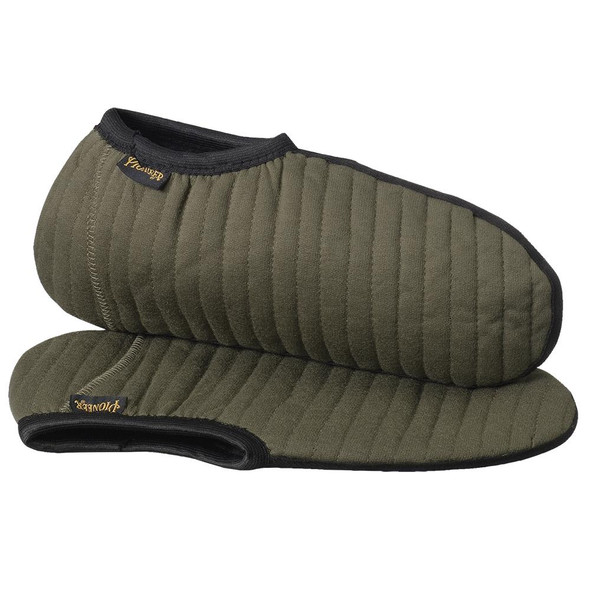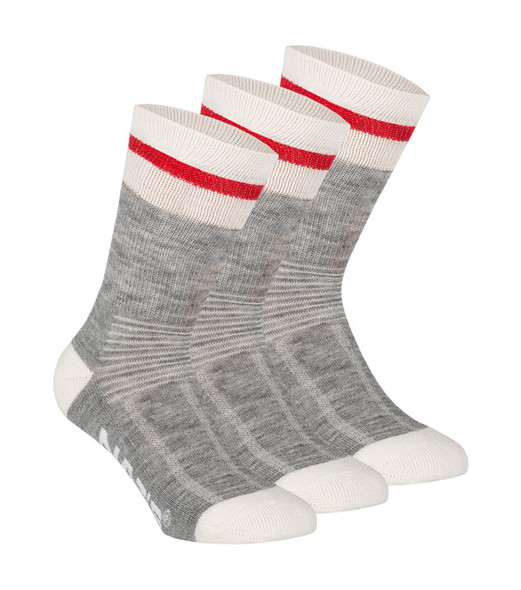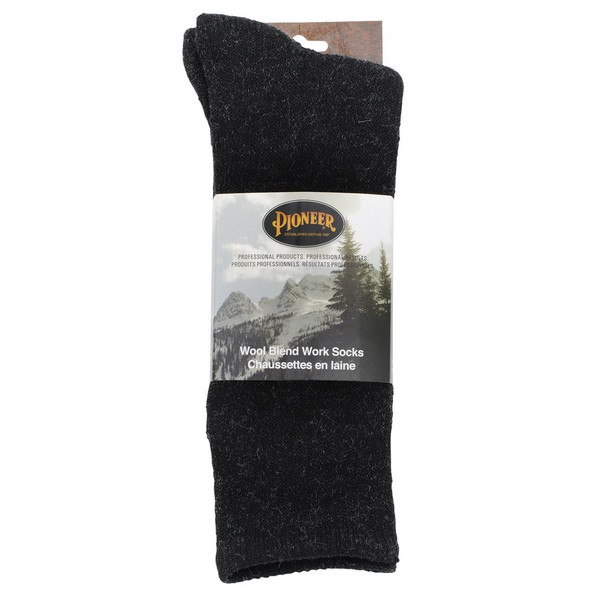
Socks/Sockettes
Understanding Safety Socks: Essential Protection for Your Feet on the Job
Safety socks and sockettes are specialized foot protection garments designed to enhance workplace comfort and safety. Unlike regular socks, these protective accessories are engineered with reinforced materials, moisture-wicking properties, and specialized design features to address specific occupational hazards. Safety socks provide crucial insulation against temperature extremes, cushioning for extended standing periods, and protection against friction that causes blisters. Professional-grade options often incorporate antimicrobial treatments to prevent odor and bacterial growth during long work shifts. These specialized foot coverings serve as an essential interface between your feet and safety footwear, working together to enhance overall protection. Workers in construction, manufacturing, oil and gas, warehousing, and outdoor industries particularly benefit from proper safety sock selection to maintain foot health and prevent workplace injuries.
Key Takeaways About Safety Socks for Workplace Protection
- Safety socks provide specialized protection beyond regular socks with reinforced materials and moisture control features.
- Proper sock selection helps prevent painful blisters, foot fatigue, and injuries during extended work periods.
- Thermal protection properties in safety socks shield workers from temperature extremes in various work environments.
- Antimicrobial treatments in professional-grade sockettes reduce odor and prevent bacterial growth during long shifts.
- Safety socks act as a crucial interface between feet and protective footwear to maximize comfort and safety.
- Compression features in specialized work socks improve circulation and reduce leg fatigue for workers standing all day.
- Selecting socks with the right thickness and material composition improves the fit and effectiveness of safety boots.
What Makes Work Socks Different: Applications and Everyday Uses
Safety socks serve numerous critical applications across various work environments. In construction and heavy industry, thermal socks protect against extreme temperatures while providing cushioning against shock and vibration from equipment operation. Workers in mining and oil fields rely on moisture-wicking compression socks to maintain proper circulation during long shifts in restrictive footwear. Sockettes offer a low-profile option for environments requiring frequent footwear changes, such as clean rooms or specialized manufacturing settings. First responders and emergency personnel benefit from flame-resistant and cut-resistant options that add an extra layer of protection in hazardous situations. Even office workers with safety requirements can benefit from ergonomically designed socks that reduce foot fatigue during long periods of standing or walking on industrial floors. The versatility of specialized work socks makes them essential personal protective equipment across virtually all industries with safety concerns.
How to Choose the Right Safety Socks: Expert Selection Guide
Selecting the optimal safety socks requires consideration of several crucial factors. Material composition stands as the primary consideration – merino wool provides excellent insulation while synthetic blends offer superior moisture management. Thickness should match both your work environment and boot fit; too thick can cause uncomfortable pressure while too thin offers inadequate protection. Experts recommend examining construction quality through reinforced heel and toe areas, which indicate durability for daily wear. Height selection should complement your 8-inch safety boots for complete ankle protection or match shorter footwear styles. Compression levels vary from mild to firm, with professional settings often requiring graduated compression to enhance circulation during long shifts. Season-appropriate choices are essential – thermal options for winter and moisture-wicking for summer work. Antimicrobial properties become crucial for multi-day wear in remote work sites, while specialized padding configurations address specific pressure points based on your primary work activities and position requirements.
Essential Features of Work Sockettes Explained for Better Selection
Understanding the key features of safety sockettes helps workers make informed decisions for maximum protection and comfort. Moisture-wicking technology actively draws sweat away from the skin, preventing blisters and fungal infections during intense activity. Reinforced toe and heel zones significantly extend product lifespan in high-friction areas that typically wear through first. Advanced models incorporate targeted cushioning that strategically places padding where pressure points develop based on specific work positions and movements. Specialized seam construction eliminates irritating ridges that can cause discomfort during extended wear with 6-inch safety boots in demanding environments. Compression zones provide graduated pressure that improves blood flow and reduces leg fatigue for workers standing throughout shifts. Insulation layers vary in thickness and material based on temperature requirements, with some models offering distinct cooling or warming zones. Antimicrobial treatments use silver ions or copper infusion to inhibit bacteria growth and neutralize odors, particularly valuable in multi-day work assignments where changing socks might not be possible.
Professional Requirements for Industrial Foot Coverings
Professional environments impose specific requirements on safety sock selection based on industry standards and workplace hazards. Industrial settings often mandate socks meeting ASTM standards for specific hazard protection, such as electrical resistance for electrical workers or thermal regulation for foundry environments. Oil and gas companies typically require flame-resistant socks certified to NFPA standards as part of comprehensive PPE programs when worn with fire-retardant safety footwear in hazardous environments. Mining operations prioritize anti-static properties that prevent spark risks in potentially explosive atmospheres. Construction professionals benefit from impact-absorbing designs that mitigate vibration transfer from power tools and heavy equipment. Healthcare and food processing industries require socks with enhanced antimicrobial properties to maintain hygiene protocols. Manufacturing facilities often specify cut-resistant materials for areas with sharp metal hazards. Professional environments also consider sock certification alongside other PPE components to ensure comprehensive protection through proper system integration, rather than viewing each safety element in isolation.
Industry-Specific Applications
Construction crews face constant exposure to impact hazards, abrasive materials, and changing weather conditions throughout projects. These workers need durable safety socks with reinforced toe and heel areas, moisture management for temperature regulation, and cushioning to absorb shock from hard surfaces and heavy tool operation. Thermal properties provide essential protection during outdoor concrete pours and framework installation in winter conditions.
Manufacturing plant operators encounter prolonged standing on hard floors, exposure to industrial chemicals, and consistent indoor climate conditions. These facilities require safety socks with graduated compression to improve circulation during stationary work, cushioned soles to reduce foot fatigue during 12-hour shifts, and moisture-wicking materials to manage perspiration inside safety footwear while operating production lines.
Oil and gas field workers face extreme weather conditions, flammable environments, and extended remote work periods without fresh supplies. These professionals depend on flame-resistant safety socks with thermal regulation properties, antimicrobial treatments for multi-day wear during rig operations, and seamless construction to prevent blisters during the physically demanding work of extraction and pipeline maintenance.
Warehouse and logistics personnel experience constant movement, repetitive lifting, and temperature variations between climate-controlled and non-controlled zones. These workers benefit from cushioned insoles paired with supportive socks that provide arch support during package handling, moisture management for temperature transitions between loading docks and storage areas, and durability to withstand high daily step counts during inventory management.
Emergency response teams face unpredictable hazards, rapid deployment requirements, and exposure to extreme environments during crisis situations. These first responders require quick-drying safety socks with reinforced construction for durability during intense activity, thermal regulation for changing conditions during extended incidents, and seamless design to prevent hot spots when running or climbing with full equipment loads.
Mining crews confront dust, moisture, confined spaces, and extended shifts in challenging underground environments. These specialists need anti-static safety sock properties for spark prevention around explosive materials, moisture-wicking capabilities to manage high humidity conditions during extraction activities, and compression features to maintain circulation during long periods of restricted movement in tight mining passages.
Daily Comfort: Practical Work Boot Socks Considerations
The daily practicality of safety socks extends beyond basic protection to significantly impact worker comfort and productivity. Moisture management becomes critical during full workdays, with high-performance work socks offering up to 10 times more effective sweat wicking than standard cotton options. Proper sock height prevents uncomfortable bunching and eliminates the safety risk of material gathering at the ankle or boot top. Workers should consider sock rotation protocols, with occupational health experts recommending a minimum three-pair rotation to ensure adequate drying between uses. Laundering requirements differ significantly from regular socks, with high-temperature washing often degrading specialized fibers and reducing protective properties. Many workers benefit from hot and cold therapy options after shifts to complement the support provided by quality work socks. Seasonal considerations remain important, as summer conditions require different moisture management than winter environments, with some workers needing distinct warm and cold weather sock inventories to maintain optimal protection year-round.
Work Hose Quality Indicators: Standards You Should Know
Understanding industry standards helps workers identify quality safety socks that deliver reliable protection. ASTM F1818 provides guidelines for thermal protective performance in foot coverings, particularly important for workers in foundries or metal fabrication. Look for CSA certification marks on packaging, indicating compliance with Canadian safety requirements for industrial use. Experts recommend examining material composition percentages, with professional-grade options typically featuring at least 30% specialized performance fibers rather than primarily cotton. Durability ratings based on abrasion resistance testing (often measured in cycles) predict longevity in harsh work conditions. Anti-static properties should meet EN 61340-5-1 requirements when working with sensitive electronics or in environments with explosion risks. Antimicrobial treatments ideally reference EPA registration numbers for verified efficacy claims. Workers should verify compression ratings (measured in mmHg) match their specific needs rather than choosing arbitrary "compression" marketing claims. Chainsaw and forestry operations require socks meeting enhanced cut-resistance standards when worn with appropriate footwear. Quality indicators extend to manufacturing consistency, with reputable brands offering lot tracking for quality control verification.
Boot Liners and Sockettes: Investment Value Explained
The economic value of quality safety socks extends far beyond their initial purchase price when considering total workplace impact. Professional-grade safety socks typically range from $15-40 per pair, representing a fraction of the investment compared to the safety footwear they complement and protect. High-quality options extend the lifespan of expensive work boots by reducing internal friction and absorbing moisture that would otherwise degrade leather and composite materials. Workers experience quantifiable productivity benefits, with studies showing proper sock selection can reduce foot-related discomfort by up to 35% during extended shifts. Compression features provide measurable circulatory benefits, potentially reducing workplace injury rates and associated costs. Budget options often false economy, wearing through in weeks rather than months, while premium thermal options create cost savings in cold environments by reducing the need for additional warming equipment. Boot liners combined with appropriate socks create an effective system that maximizes both protection and value. Many employers now include professional-grade safety socks in PPE allowances, recognizing their importance in comprehensive protection systems and their impact on reducing workplace injury claims.
Safety Sock Selection Checklist
- Verify material composition meets your specific workplace hazard requirements.
- Check that thickness provides adequate cushioning without compromising boot fit.
- Measure sock height against boot height to ensure complete coverage.
- Identify moisture-wicking capabilities appropriate for your work environment.
- Consider antimicrobial treatment needs based on shift length and conditions.
- Evaluate compression levels needed for your standing/movement requirements.
- Calculate value based on durability ratings rather than just purchase price.
- Inspect reinforcement in high-wear areas to maximize product lifespan.
- Product
- Qty in Cart
- Quantity
- Price
- Subtotal
-


WK962 | Women's Thermal Socks | Nat's
Nat's Boots
$9.99DESCRIPTION Even if these women's thermal socks are designed for your comfort, they also offer a wide color selection that is sure to please more than one. Their extra thick construction ensures your feet to stay warmer longer. These are the perfect...$9.99 -


Pioneer Boot Sockettes - Pair | Pioneer
Pioneer Workwear
$17.35Description With its unique 2 layer thermo system the Pioneer boot sockettes help keep your feet warm and comfortable throughout the day. 2-layer thermo system has an outside cotton material to provide moisture absorption and an inside acrylic fleece...$17.35 -

WK920 | Men's Work Socks (3-Pair Pack) | Nat's
Nat's Boots
$17.99DESCRIPTION Get yourself these typical work socks, offered in a 3 pack. PRODUCT DETAILS 78% polyester, 20% wool, 2% spandex. One size (9-12).$17.99 -

Viking AMC Socks | Viking
Viking Workwear
$18.00Description Designed to fit all full rubber and rubber bottom boots The dual-layer thermal, acrylic/cotton, construction provides ventilation while wicking perspiration away from your feet Outside cotton layer to absorb and wick moisture Acrylic fleece...$18.00 -

Viking AMC Neoprene Socks | Viking
Viking Workwear
$24.75Viking AMC Neoprene Socks | Viking Triple layer air moisture control system provides ventilation while wicking away perspiration from your feet Conforms to your feet for maximum comfort Ideal for rubber or PU boots Machine washable$24.75 -

Oxford Winter Insulated Socks | Helly Hansen
Helly Hansen
$25.00Oxford Winter Insulated Socks No. 79645 This full terry leg ergonomic sock has great durability and helps keep you warm and comfortable. Details Fiber content: Main fabric: 34% polyamide, 32% Merino wool, 32% acrylic, 2% elastane Care...$25.00 -

Manchester Socks 3-Pack | Helly Hansen
Helly Hansen
$25.00Manchester Socks 3-Pack No. 79646 The Manchester sock has added breathability through mesh ventilation and the ankle flex makes them comfortable for longer. Comes in a 3-pack. Details Fiber content: Main fabric: 71% cotton, 26% polyamide, 3%...$25.00 -


WK929 | Work Socks with Merino Wool (3-Pair Pack) | Nat's
Nat's Boots
$29.99DESCRIPTION These socks contain merino wool. Moreover, they feature vented and cushioned zones for better comfort. Ideal to wear with all kinds of footwear including safety footwear. PRODUCT DETAILS 49% acrylic, 28% polyester, 21% merino wool, 2%...$29.99 -

Chelsea Evolution Winter Insulated Socks | Helly Hansen
Helly Hansen
$30.00Chelsea Evolution Winter Insulated Socks No. 79643 With Lifa fibers added in the heel & toe, these technical socks constantly work to keep the foot dry and at a comfortable temperature in cold weather. Details Fiber content: Main fabric: 39%...$30.00 -

Magni Winter Insulated Socks | Helly Hansen
Helly Hansen
$35.00Magni Winter Insulated Socks No. 79641 These advanced socks are packed with highly effective features boosting the ergonomics of the foot and ankle, alleviating unnecessary strain while simultaneously regulating the temperature of the foot, keeping it...$35.00 -


NT0001 | Coolmax work socks (3-pair pack) | Nat's
Nat's Boots
$39.99DESCRIPTION These socks contain merino wool. Moreover, they feature vented and cushioned zones for better comfort. Ideal to wear with all kinds of footwear including safety footwear. PRODUCT DETAILS 41% cotton, 38% Coolmax, 19% polyester, 2% elastane...$39.99 -

Thermal Wool Blend Socks - 12-Pack | Pioneer
Pioneer Workwear
$73.44Description Premium socks that are built for the outdoors and crafted from a premium wool blend for all-day warmth and comfort. Crafted from a premium wool blend for all-day comfort Superb fit stays firmly on and doesn't slide Significantly warmer than...$73.44
